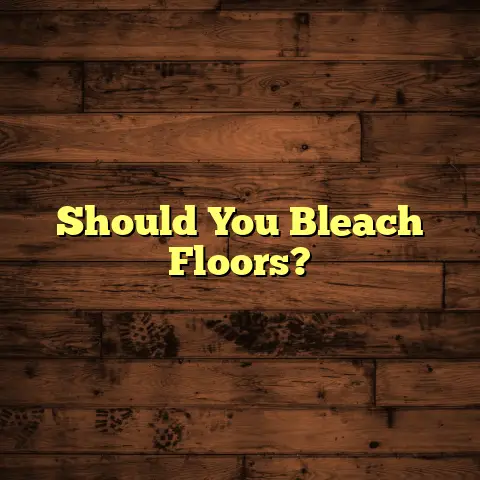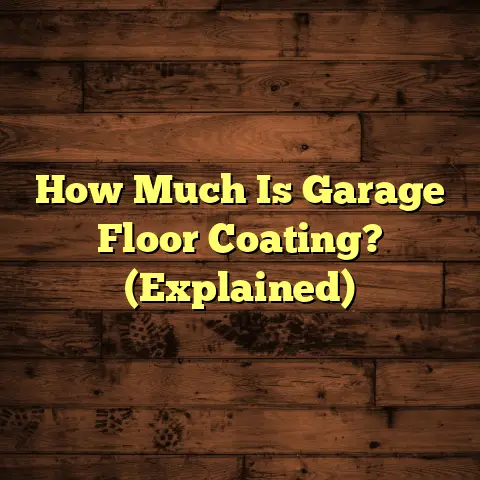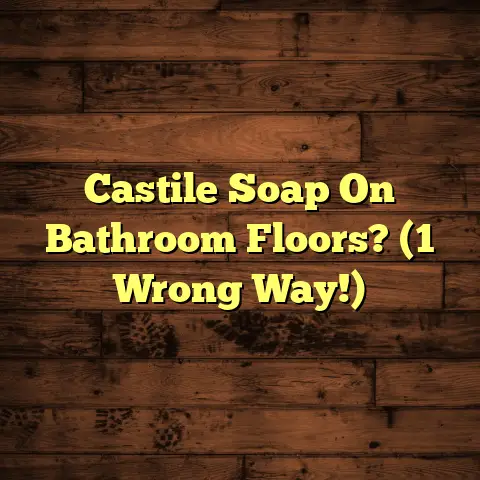Remove Super Glue From Floors? (5 Min Fix!)
Ever had that heart-stopping moment when a rogue drop of super glue lands on your pristine floor?
You’re not alone!
I’ve seen countless homeowners panic, reaching for the nearest abrasive cleaner or sharp tool.
Trust me, that’s usually the worst thing you can do.
Instead of potentially causing permanent damage, let’s explore a gentle, effective way to remove super glue – often in just 5 minutes!
Section 1: Understanding Super Glue and Its Effects on Flooring
So, what exactly is super glue?
Well, the main ingredient is cyanoacrylate.
This stuff bonds incredibly quickly, forming a strong, rigid polymer.
Think of it like tiny chains linking together, creating a solid connection.
Why is this a problem for your floors?
Because super glue doesn’t discriminate.
It’ll bond to pretty much anything, including:
- Wood: Penetrates pores, making removal tricky.
- Laminate: Can damage the protective top layer.
- Tile: Bonds to the glaze or grout.
- Vinyl: May cause discoloration or melting.
- Carpet: Seizes fibers together, creating a stiff spot.
The chemical process of bonding is rapid.
When cyanoacrylate comes into contact with moisture (even the humidity in the air), it polymerizes almost instantly.
That’s why it’s so difficult to remove once it’s fully cured.
Time is of the essence! The quicker you act, the less likely the glue is to form a permanent bond.
Section 2: Assessing the Situation
Before you grab any cleaning supplies, take a moment to assess the damage.
- How big is the spill? A tiny drop is much easier to handle than a large puddle.
What type of flooring do you have? This is crucial.
Different materials require different approaches.- Hardwood: Can be sensitive to solvents.
- Laminate: Prone to scratching.
- Tile: Grout is porous and can absorb glue.
- Vinyl: Can be damaged by acetone.
- Carpet: Requires a different technique altogether.
Always test your chosen cleaning method in an inconspicuous area first! This could be inside a closet, under a rug, or in a corner.
This helps to ensure that the cleaner doesn’t damage or discolor your flooring.
Section 3: Essential Tools and Materials for Removal
Alright, let’s get our arsenal ready. Here’s what you’ll need:
- Plastic Scraper: A dull plastic scraper is your best friend.
Avoid metal scrapers, as they can easily scratch your floors. - Acetone (Nail Polish Remover): Acetone is a solvent that can dissolve super glue.
- Important: Always check the manufacturer’s instructions for your specific flooring type before using acetone.
For example, acetone can damage some types of vinyl flooring.
- Important: Always check the manufacturer’s instructions for your specific flooring type before using acetone.
- Cotton Balls or Soft Cloths: For applying acetone and wiping away residue.
- Warm Soapy Water: For cleaning the area after glue removal.
- Clean, Dry Cloth: For buffing the area.
- Optional:
- Hair Dryer: To gently soften the glue.
- Goo Gone Adhesive Remover: A commercial adhesive remover that’s safe for many surfaces.
Section 4: Step-by-Step Guide to Removing Super Glue
Okay, let’s get down to business.
Here’s how to remove super glue from different types of flooring:
General Steps (Applicable to Most Flooring Types):
- Preparation: Ensure the area is well-ventilated.
Open windows or turn on a fan.
Remove any nearby objects that could get in the way. - Application of Acetone:
- Dip a cotton ball or soft cloth into acetone.
- Gently dab the acetone onto the super glue.
- Let it sit for a few minutes to soften the glue.
Don’t pour acetone directly onto your floor!
- Scraping:
- Using the plastic scraper, gently lift the edge of the glue.
- Work slowly and carefully to avoid scratching the surface.
- If the glue is stubborn, reapply acetone and let it sit for a bit longer.
- Cleaning Up:
- Once the glue is removed, wipe the area with warm soapy water to remove any acetone residue.
- Dry the area thoroughly with a clean cloth.
- Final Touches:
- Inspect the area for any remaining residue.
- If necessary, use a floor polish or wax to restore the flooring’s shine.
Specific Instructions by Flooring Type:
- Hardwood:
- Be extra cautious with acetone.
Apply it sparingly and avoid letting it sit for too long. - After cleaning, apply a wood polish or wax to protect the finish.
- Be extra cautious with acetone.
- Laminate:
- Avoid using excessive amounts of acetone, as it can damage the laminate’s top layer.
- Use a gentle scraping motion to prevent scratches.
- Tile:
- Acetone is generally safe for tile, but it can damage grout.
- If the glue is on the grout, use a grout brush to scrub away any residue.
- Vinyl:
- Test acetone in an inconspicuous area first. Some types of vinyl can be damaged by acetone.
- If acetone is not safe, try using warm soapy water and a soft cloth.
You can also try using mineral oil.
Apply mineral oil to the glue stain and let it sit for a few hours.
Then wipe it off with a clean cloth.
- Carpet:
- Softening the Glue: Apply a small amount of rubbing alcohol or a commercial carpet stain remover to the glue.
Let it sit for a few minutes. - Blotting: Use a clean cloth to blot the area.
Avoid rubbing, as this can spread the glue and damage the carpet fibers. - Cutting (If Necessary): If the glue is deeply embedded, you may need to carefully trim the affected carpet fibers with scissors.
- Vacuuming: Once the area is dry, vacuum it to remove any loose fibers.
- Softening the Glue: Apply a small amount of rubbing alcohol or a commercial carpet stain remover to the glue.
Section 5: Common Mistakes to Avoid
I’ve seen it all, folks.
Here are some common mistakes people make when trying to remove super glue:
- Using Abrasive Scrubbing Tools: Steel wool, scouring pads, and other abrasive tools will scratch your floors.
- Using Metal Scrapers: Same as above. Stick to plastic!
- Over-Saturating the Area with Solvents: This can damage the flooring and seep into the subfloor.
- Using Harsh Chemicals: Bleach, ammonia, and other harsh chemicals can discolor or damage your floors.
- Rushing the Process: Patience is key.
Work slowly and carefully to avoid damaging the surface. - Ignoring Manufacturer’s Instructions: Always check the manufacturer’s instructions for your specific flooring type before using any cleaning products.
Section 6: Alternative Methods for Stubborn Glue
Sometimes, super glue is just plain stubborn.
If the acetone method doesn’t work, here are some alternative approaches:
- Heat (Hair Dryer): Use a hair dryer on a low setting to gently heat the glue.
This can soften it and make it easier to scrape away.
Be careful not to overheat the area, as this could damage the flooring. - Specialized Adhesive Removers: Products like Goo Gone Adhesive Remover are designed to dissolve adhesives.
Follow the manufacturer’s instructions carefully. - Mineral Spirits: Mineral spirits can also dissolve super glue.
However, they are flammable and should be used with caution.
Be sure to ventilate the area well and avoid using mineral spirits near open flames. - Peanut Butter: Sounds crazy, right?
But the oils in peanut butter can sometimes break down the glue’s bond.
Apply a small amount of peanut butter to the glue, let it sit for 30 minutes, and then try scraping it away.
Section 7: Preventing Future Incidents
Prevention is always better than cure!
Here are some tips for avoiding super glue spills in the future:
- Use Protective Coverings: When working with super glue, cover your floors with drop cloths or mats.
- Work in a Well-Ventilated Area: This will help to prevent fumes from building up.
- Use a Precision Applicator: If you’re working with a small amount of super glue, use a precision applicator to avoid spills.
- Be Careful! This may sound obvious, but take your time and be mindful of where you’re placing the glue.
Conclusion
Removing super glue from your floors can seem daunting, but it’s definitely achievable with the right approach.
Remember to:
- Identify your flooring type.
- Test any cleaning method in an inconspicuous area first.
- Use gentle techniques and avoid harsh chemicals.
- Be patient!
With a little bit of elbow grease and the right tools, you can get rid of that super glue spill in no time, keeping your floors looking their best.
And remember, if you’re ever unsure, it’s always best to consult with a professional flooring contractor.





